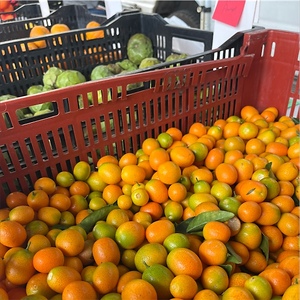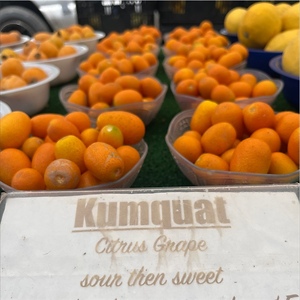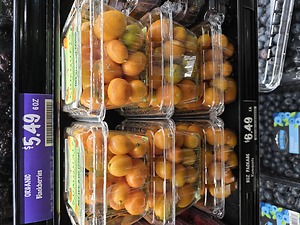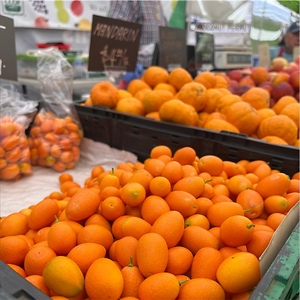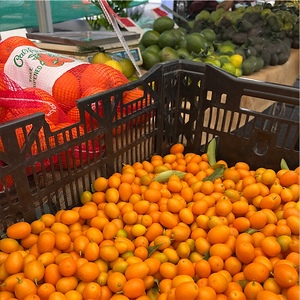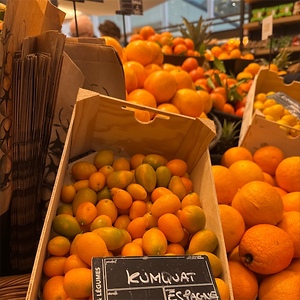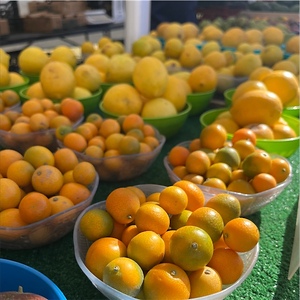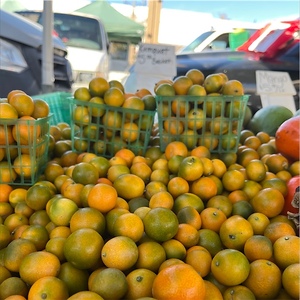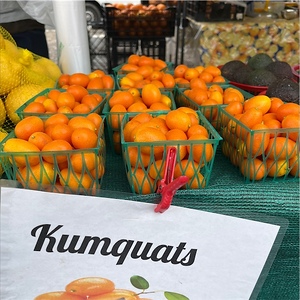

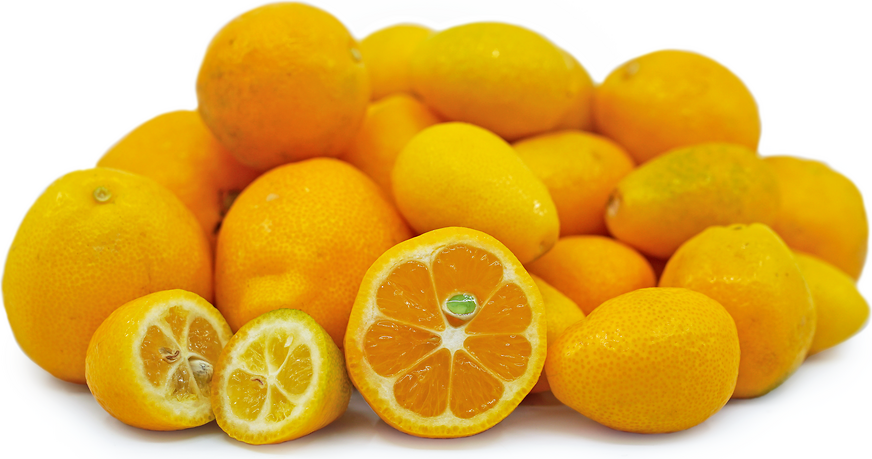
Kumquats
Estimated Inventory, 10 lbs : 0
This item was last sold on : 05/28/25
Description/Taste
Kumquats are small fruits, averaging 2 to 5 centimeters in length, and have an oval, round to oblong shape. The fruit’s skin is thin, ripening from green to golden yellow, orange, or red-orange, depending on the variety, and has a glossy, taut appearance with prominent oil glands scattered across the surface. The skin also clings tightly to the flesh, and there is little to no bitter white pith present in the fruit. The flesh is divided into 3 to 6 segments and is semi-aqueous and tender, encasing a few cream-colored seeds. Kumquats are a unique citrus as the entire fruit is edible, including the peel, flesh, and seeds. The fruit’s peel is sweet, subtly floral, and fruity, balancing the tart, sour taste of the flesh, creating an intense sweet-tart combination with a zesty, citrus zing.
Seasons/Availability
Kumquats have multiple fruiting seasons throughout the year in Asia and Southeast Asia. In the United States, the fruits are primarily available in the winter through early summer.
Current Facts
Kumquats, botanically classified as Citrus japonica, are small, sweet-tart fruits belonging to the Rutaceae family. The fruits grow in clusters on evergreen trees, reaching 2 to 4 meters in height, and each tree can produce hundreds of fruits per season. Kumquats are native to Asia, and the name Kumquat roughly translates from Cantonese words to mean “golden orange.” The cold-hardy citrus is favored for its edible peel, small size, and bright, zesty flavor. Experts believe there are approximately 4 to 6 varieties of Kumquats and the three most cultivated species worldwide include Nagami, Marumi, and Meiwa. In Asia, Kumquats have been intertwined with the Lunar New Year Festival and often symbolize good luck and prosperity. The trees are commonly planted in doorways or grown as bonsai, and the fruits are also cut from the tree with glossy green leaves to use as gifts to families and friends. Outside of Asia, Kumquats have remained a niche market citrus but are growing in popularity as chefs, social media, and growers educate consumers on the fruit’s commercial value.
Nutritional Value
Kumquats are an excellent source of fiber to regulate the digestive tract and vitamin C to strengthen the immune system and reduce inflammation. The fruits also contain manganese, vitamin A to maintain healthy organ functioning, calcium to protect bones and teeth, and provide lower amounts of iron, zinc, potassium, vitamin E, and copper. Inside the sweet peel, essential oils such as limonene and flavonoids offer antioxidant and anti-inflammatory properties. Herbalists in Asia also use Kumquats as a remedy for symptoms of colds and flu. The fruits are traditionally smashed, mixed with ginger, salt, and honey, and steeped as a soothing tea.
Applications
Kumquats are entirely edible, well suited for flavoring both raw and cooked preparations. The fruits can be consumed straight, out of hand, or they can be sliced and tossed into green and fruit salads, layered over avocado toast, chopped into salsa, or pickled to create a sweet and sour topping. It is important to note that the seeds in the flesh are edible and can be used as a natural source of pectin for jams and jellies. Kumquats can also be utilized in savory preparations, diced and cooked into sauces, braising liquids, and glazes for meat or stirred into couscous and stuffing for a tangy flavor. In sweet preparations, Kumquats can be candied, baked into muffins, cakes, and pies, simmered into marmalade, jams, and chutney, or they can be cooked into a syrup for tarts, ice cream, and yogurt. In mixology, the fruits are used as an edible garnish and can be infused into vodka for a citrus twist. The fruits can also be sliced and stirred into champagne cocktails, fruit punches, or sparkling juices. Kumquats pair well with nuts such as almonds, pecans, and walnuts, fruits, including calamondin, blood oranges, pineapple, kiwis, cranberries, and cherries, mint, honey, ginger, meats such as pork, duck, and poultry, seafood, and greens including watercress, spinach, endive, and frisee. Whole, unwashed Kumquats will keep up to seven days at room temperature. When stored in the refrigerator in a sealed container, the fruits will keep 1 to 2 weeks.
Ethnic/Cultural Info
In Dade City, Florida, the Kumquat Festival® celebrates Florida-grown Kumquats. The annual event has been held for over twenty-four years and was established by the Greater Dade City Chamber of Commerce to increase tourism and boost the economy. During the festival, over 400 vendors line city streets to sell crafts, fresh fruits, homemade baked goods, and Kumquat-infused dishes, including ice cream, salsa, vinaigrettes, marmalade, cookies, pies, and cocktails. Two days before the festival, local Kumquat growers also host open houses and allow visitors to tour the farms. Visitors can attend educational talks, grove and packing tours, and sample the different Kumquat varieties being grown. These open houses allow the growers to connect with the consumers, creating space to share the importance of Kumquat production within the region.
Geography/History
Kumquats are native to Southeast Asia and have been growing wild since ancient times. The fruits were first documented in China in the 12th century, grown for culinary, medicinal, and cultural uses, and were symbolically believed to bring good luck and prosperity when placed in households. Kumquats were also extensively cultivated in Taiwan, Japan, the Philippines, and India in the early ages. In 1846, Kumquats were introduced into Europe by Robert Fortune, a Scottish botanist who was also a plant explorer for the London Horticultural Society. From Europe, Kumquats were brought to North America with immigrants and were planted in Florida as a potential fruit for commercial cultivation. Today Kumquats are primarily grown in California and Florida of the United States, sometimes on a smaller scale in Texas and Louisiana, and are also cultivated in Asia, the Middle East, South Africa, Australia, Europe, and Central and South America. When in season, the fruits can be found fresh at farmer’s markets, specialty grocers, and select supermarkets.
Recipe Ideas
Recipes that include Kumquats. One



